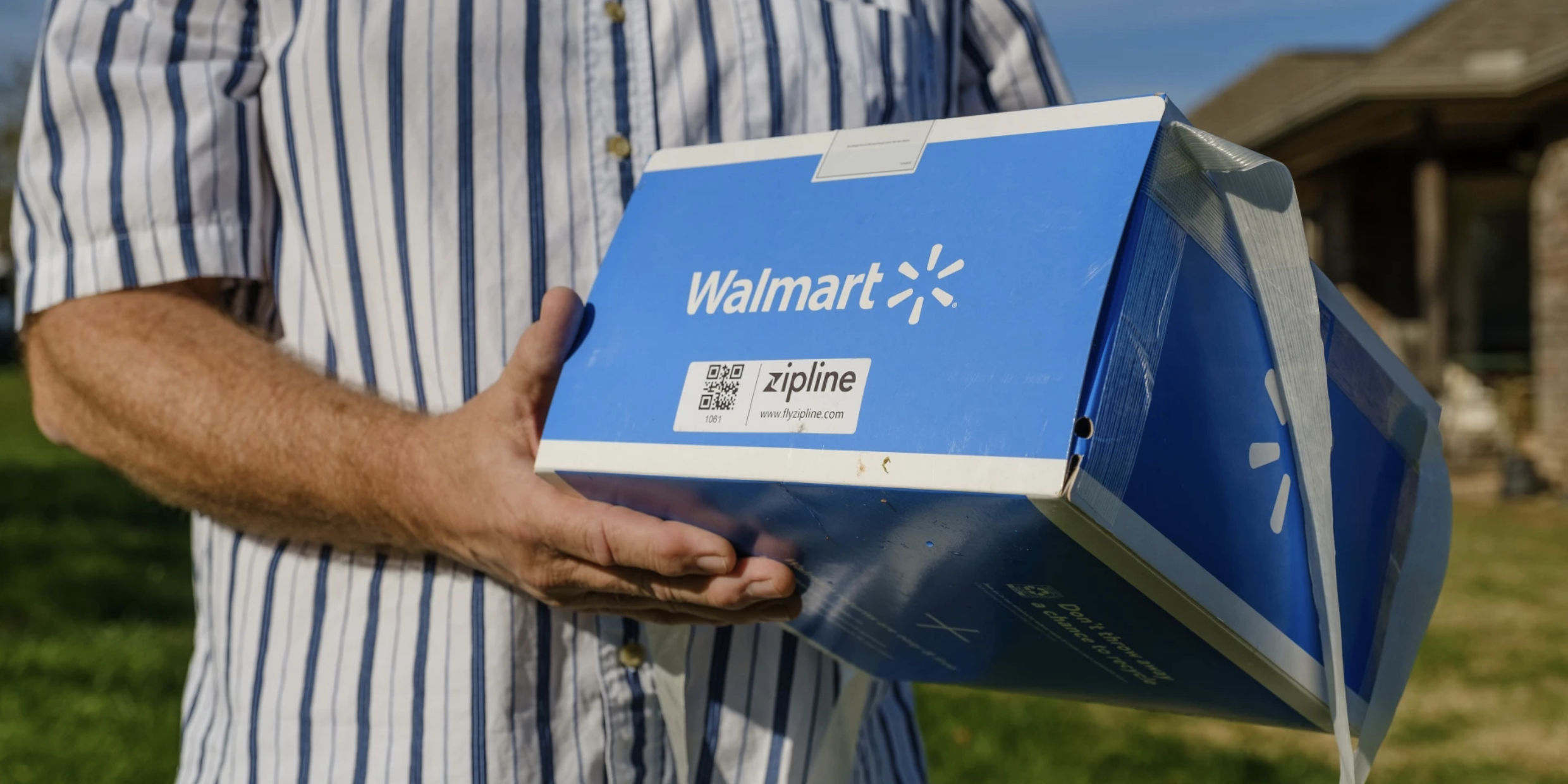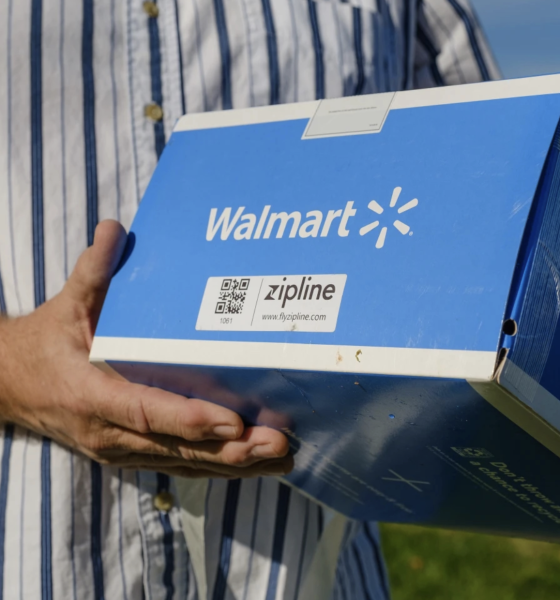Update 12/22 4:57 PM: Updates to reflect accuracy in paragraphs 4 and 6.
This morning, a video posted on TikTok shows the Walmart drone delivery system in action.
As the battle for e-commerce dominance has escalated over the past few years, Walmart has taken to the skies to battle with Amazon to be the first to offer drone delivery of customer orders. Today, Walmart’s system was demonstrated and explained in a video on TikTok.
Walmart’s drone delivery system is being created in partnership with a company called Zipline, which designs and manufactures drones and their autonomous flying systems. The video, originally posted by user victorbravo248 on TikTok, shows a Zipline drone getting loaded with a package, being assembled on its launching system, and taking off.
@victorbravo248 Walmart drone delivering #technology #delivery ♬ original sound – victor bravo
Zipline’s drone is unlike the drones that many people have become familiar with. Instead of a traditional “quad-copter” design, it is more like a plane with a set of wings and two motors: one rear-facing and one forward-facing. As seen in the video, each drone can hold a single package, which is then dropped with a parachute as the drone flies over the customer’s house. The drone flies and lands autonomously and is expected to make several package deliveries daily.
Walmart is also working with competitor DroneUp which produces more traditional drone technology for package delivery using a quad-copter design. This is the more ideal design for dense urban areas where space and package delivery areas would be hard to come by.
According to Zipline, each drone has an operational range of 50 miles from any launch point and has already proven itself in nearly 500,000 commercial deliveries worldwide since 2016. One commercial delivery is completed every two minutes. The drone requires only basic infrastructure, including its launching device, landing tower, and an area for loading and assembling.
@victorbravo248 Part 2 #delivery #technology #walmart #sanbenito ♬ original sound victor bravo
Walmart first secured its deal with Zipline in 2020, and since then, the program with Walmart and Zipline as a company have grown. Walmart is completing initial testing in its home state of Arkansas, and Zipline has expanded to numerous other sectors. Notably, Zipline now works to deliver health supplies and humanitarian aid to many countries in Africa.
“Zipline’s autonomous aircraft presents an incredible opportunity to offer customers an on-demand delivery option for the items they need now, such as a thermometer, non-prescription medication, or an emergency pack of diapers,” said Tom Ward, senior vice president of Last Mile Delivery, Walmart U.S. “Even more, Zipline’s aircraft can help provide immediate access to needed items for both hard-to-reach and at-risk populations, such as rural communities and elderly customers. By bringing this game-changing technology to the rural community of Pea Ridge, Arkansas, we’re continuing to look for ways to make shopping with Walmart convenient and easy – for everyone.”
Walmart has not specified when the drone delivery program will be expanded to other service locations. But if recent statements and Zipline’s recent approval from the FAA are anything to go by, it could be coming sooner than many would think. Furthermore, the drone program could likely aid Walmart’s aggressive sustainability push, only further incentivizing the company to make the program public sooner rather than later.
What do you think of the article? Do you have any comments, questions, or concerns? Shoot me an email at william@teslarati.com. You can also reach me on Twitter @WilliamWritin. If you have news tips, email us at tips@teslarati.com!

Elon Musk
Elon Musk and Tesla AI Director share insights after empty driver seat Robotaxi rides
The executives’ unoccupied tests hint at the rapid progress of Tesla’s unsupervised Robotaxi efforts.

Tesla CEO Elon Musk and AI Director Ashok Elluswamy celebrated Christmas Eve by sharing personal experiences with Robotaxi vehicles that had no safety monitor or occupant in the driver’s seat. Musk described the system’s “perfect driving” around Austin, while Elluswamy posted video from the back seat, calling it “an amazing experience.”
The executives’ unoccupied tests hint at the rapid progress of Tesla’s unsupervised Robotaxi efforts.
Elon and Ashok’s firsthand Robotaxi insights
Prior to Musk and the Tesla AI Director’s posts, sightings of unmanned Teslas navigating public roads were widely shared on social media. One such vehicle was spotted in Austin, Texas, which Elon Musk acknowleged by stating that “Testing is underway with no occupants in the car.”
Based on his Christmas Eve post, Musk seemed to have tested an unmanned Tesla himself. “A Tesla with no safety monitor in the car and me sitting in the passenger seat took me all around Austin on Sunday with perfect driving,” Musk wrote in his post.
Elluswamy responded with a 2-minute video showing himself in the rear of an unmanned Tesla. The video featured the vehicle’s empty front seats, as well as its smooth handling through real-world traffic. He captioned his video with the words, “It’s an amazing experience!”
Towards Unsupervised operations
During an xAI Hackathon earlier this month, Elon Musk mentioned that Tesla owed be removing Safety Monitors from its Robotaxis in Austin in just three weeks. “Unsupervised is pretty much solved at this point. So there will be Tesla Robotaxis operating in Austin with no one in them. Not even anyone in the passenger seat in about three weeks,” he said. Musk echoed similar estimates at the 2025 Annual Shareholder Meeting and the Q3 2025 earnings call.
Considering the insights that were posted Musk and Elluswamy, it does appear that Tesla is working hard towards operating its Robotaxis with no safety monitors. This is quite impressive considering that the service was launched just earlier this year.
Elon Musk
Starlink passes 9 million active customers just weeks after hitting 8 million
The milestone highlights the accelerating growth of Starlink, which has now been adding over 20,000 new users per day.

SpaceX’s Starlink satellite internet service has continued its rapid global expansion, surpassing 9 million active customers just weeks after crossing the 8 million mark.
The milestone highlights the accelerating growth of Starlink, which has now been adding over 20,000 new users per day.
9 million customers
In a post on X, SpaceX stated that Starlink now serves over 9 million active users across 155 countries, territories, and markets. The company reached 8 million customers in early November, meaning it added roughly 1 million subscribers in under seven weeks, or about 21,275 new users on average per day.
“Starlink is connecting more than 9M active customers with high-speed internet across 155 countries, territories, and many other markets,” Starlink wrote in a post on its official X account. SpaceX President Gwynne Shotwell also celebrated the milestone on X. “A huge thank you to all of our customers and congrats to the Starlink team for such an incredible product,” she wrote.
That growth rate reflects both rising demand for broadband in underserved regions and Starlink’s expanding satellite constellation, which now includes more than 9,000 low-Earth-orbit satellites designed to deliver high-speed, low-latency internet worldwide.
Starlink’s momentum
Starlink’s momentum has been building up. SpaceX reported 4.6 million Starlink customers in December 2024, followed by 7 million by August 2025, and 8 million customers in November. Independent data also suggests Starlink usage is rising sharply, with Cloudflare reporting that global web traffic from Starlink users more than doubled in 2025, as noted in an Insider report.
Starlink’s momentum is increasingly tied to SpaceX’s broader financial outlook. Elon Musk has said the satellite network is “by far” the company’s largest revenue driver, and reports suggest SpaceX may be positioning itself for an initial public offering as soon as next year, with valuations estimated as high as $1.5 trillion. Musk has also suggested in the past that Starlink could have its own IPO in the future.
News
NVIDIA Director of Robotics: Tesla FSD v14 is the first AI to pass the “Physical Turing Test”
After testing FSD v14, Fan stated that his experience with FSD felt magical at first, but it soon started to feel like a routine.

NVIDIA Director of Robotics Jim Fan has praised Tesla’s Full Self-Driving (Supervised) v14 as the first AI to pass what he described as a “Physical Turing Test.”
After testing FSD v14, Fan stated that his experience with FSD felt magical at first, but it soon started to feel like a routine. And just like smartphones today, removing it now would “actively hurt.”
Jim Fan’s hands-on FSD v14 impressions
Fan, a leading researcher in embodied AI who is currently solving Physical AI at NVIDIA and spearheading the company’s Project GR00T initiative, noted that he actually was late to the Tesla game. He was, however, one of the first to try out FSD v14.
“I was very late to own a Tesla but among the earliest to try out FSD v14. It’s perhaps the first time I experience an AI that passes the Physical Turing Test: after a long day at work, you press a button, lay back, and couldn’t tell if a neural net or a human drove you home,” Fan wrote in a post on X.
Fan added: “Despite knowing exactly how robot learning works, I still find it magical watching the steering wheel turn by itself. First it feels surreal, next it becomes routine. Then, like the smartphone, taking it away actively hurts. This is how humanity gets rewired and glued to god-like technologies.”
The Physical Turing Test
The original Turing Test was conceived by Alan Turing in 1950, and it was aimed at determining if a machine could exhibit behavior that is equivalent to or indistinguishable from a human. By focusing on text-based conversations, the original Turing Test set a high bar for natural language processing and machine learning.
This test has been passed by today’s large language models. However, the capability to converse in a humanlike manner is a completely different challenge from performing real-world problem-solving or physical interactions. Thus, Fan introduced the Physical Turing Test, which challenges AI systems to demonstrate intelligence through physical actions.
Based on Fan’s comments, Tesla has demonstrated these intelligent physical actions with FSD v14. Elon Musk agreed with the NVIDIA executive, stating in a post on X that with FSD v14, “you can sense the sentience maturing.” Musk also praised Tesla AI, calling it the best “real-world AI” today.










